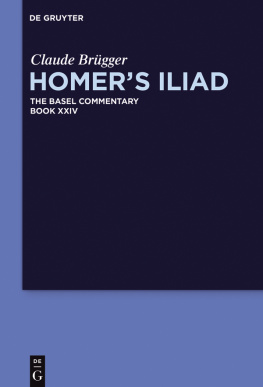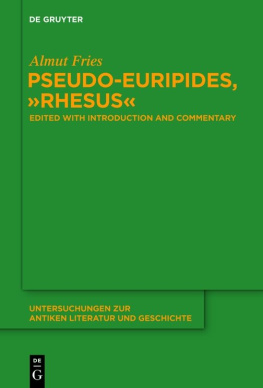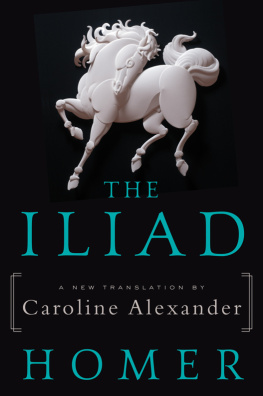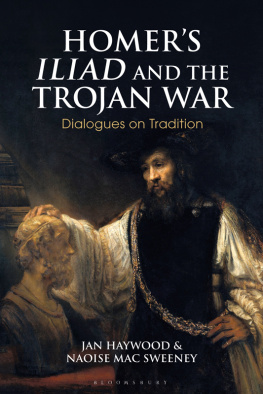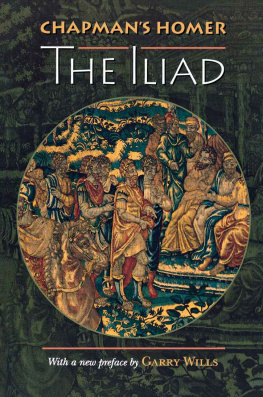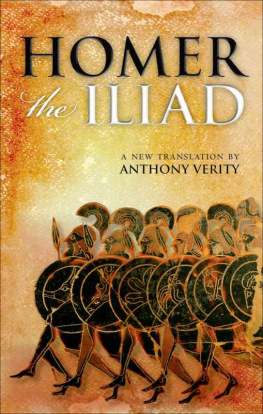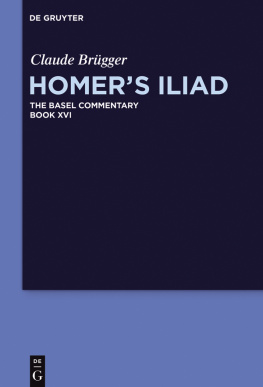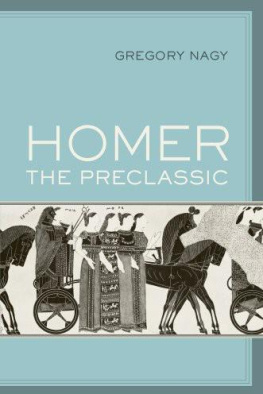Table of Contents
Guide

Homers Iliad
The Basel Commentary
Homers Iliad
The Basel Commentary
Editors
Anton Bierl and Joachim Latacz
Managing Editor
Magdalene Stoevesandt
General Editor of the English Edition
S. Douglas Olson

The publication of Homers Iliad: The Basel Commentary has been made possible by the kind financial support from the following organizations:
Stavros Niarchos Foundation
Freiwillige Akademische Gesellschaft (FAG), Basel
L. & Th. La Roche Stiftung, Basel
ISBN 978-1-5015-1229-2
e-ISBN (PDF) 978-1-5015-0439-6
e-ISBN (EPUB) 978-1-5015-0429-7
Library of Congress Cataloging-in-Publication Data
A CIP catalog record for this book has been applied for at the Library of Congress.
Bibliographic information published by the Deutsche Nationalbibliothek
The Deutsche Nationalbibliothek lists this publication in the Deutsche Nationalbibliografie; detailed bibliographic data are available in the Internet at http://dnb.dnb.de.
2017 Walter de Gruyter Inc., Boston/Berlin
www.degruyter.com
Preface
,
.
Iliad 24.399 f.
Following on the publication of the Prolegomena and the commentaries on Books 1, 2, 3, 6, and 19 of the Iliad , the present volume presents the commentary on Book 24, the final book of the Iliad . This Book is undoubtedly one of the most touching and stimulating sections of Homeric epic; this was another reason for not delaying the commentary on it until the end of the project, but instead bringing it forward within the overall concept of the series (on which, see the preface in volume II.2, pp. VIIf.). In this regard, the present volume follows the principles of commenting outlined in the ones that preceded it (esp. vols. I.2 and IV.2).
The existence of first-rate commentaries, including those by Rudolf Peppmller (1876), Colin W. Macleod (1982) and Nicholas J. Richardson (1993), (24.367), as well as monographs by e.g. Gtz Beck (1964) and Karl Deichgrber (1972) to mention only the most pertinent from the vast bibliography both facilitates and impedes a new treatment of Book 24 and its 804 verses. My initial aim to encapsulate what has been recognized and well discussed, and perhaps to go a bit beyond this here and there has proved almost overly ambitious. If the undertaking has nevertheless come to a happy conclusion and one that will, I hope, be fruitful for further research, I am indebted to a number of institutions:
the Schweizerischer Nationalfonds zur Frderung der wissenschaftlichen Forschung and the Hamburger Stiftung zur Frderung von Wissenschaft und Kultur , which took a leading role in facilitating the completion of this commentary via their generous financial support;
the Freiwillige Akademische Gesellschaft Basel and the Max Geldner-Stiftung Basel , which supported the entire project financially;
the University of Basel and the library of the University of Basel, which substantially facilitated my research by providing infrastructure and awarding me a privileged user status;
the Walter de Gruyter publishing house, which, in the person of Dr. Elisabeth Schuhmann, followed the development of this volume with great goodwill and interest (the careful technical production of the volume by Florian Ruppenstein has also to be mentioned with gratitude).
I am personally greatly indebted to:
my esteemed teacher Prof. Dr. Joachim Latacz, who has unflaggingly encouraged me during both my studies and my lengthy collaboration on the research project he initiated, and who has shown unqualified confidence in me;
Prof. Dr. Anton Bierl, who continually followed this work and provided a welcome opportunity to try out a preliminary version of the commentary in the context of a seminar with interested students;
my colleagues Dr. Marina Coray, Dr. Martha Krieter-Spiro, Dr. Magdalene Stoevesandt and Prof. Dr. Robert Plath, who spared neither time nor effort in critically reading draft versions and sharing their knowledge with me;
the external experts, who offered valuable advice based on their individual areas of expertise and saved me from many errors: Rudolf Fuhrer, Fritz Graf, Irene de Jong, Michael Meier-Brugger, Sebastiaan R. van der Mije, Ren Nunlist, Rolf A. Stucky, Jurgen von Ungern-Sternberg, Rudolf Wachter and Martin L. West .
Prof. Dr. Michael Meier-Brgger and the staff of the Lexikon des frhgriechischen Epos ( LfgrE ), who in May 2006 invited me, together with Magdalene Stoevesandt, to Hamburg for a fruitful exchange and who also continuously and readily entrusted the team of the Basel commentary with unpublished versions of individual lemmata from not yet published fascicles of the LfgrE ;
the student assistants Tamara Hofer and Alexandra Scharfenberger, who read through the proofs with a keen eye and alert mind;
all the other individuals who helped me on individual issues with suggestions, advice and by sending relevant material;
my parents, who facilitated my studies in Classical Philology, and my family, who sometimes had to forego a husband or father for the sake of Homer.
To all, I express my heartfelt thanks.
| Basel, August 2009 | Claude Brgger |
The present English edition has been made possible by the support of the Stavros Niarchos Foundation, the Freiwillige Akademische Gesellschaft Basel (FAG) and the L. & Th. La Roche Stiftung Basel, as well as the publisher Walter de Gruyter (Boston/Berlin). During the revision of the text for the English edition, errors were corrected and in some cases bibliographic references were supplemented (January 2015). Particular thanks are due to the translators Dr. Sarah Strack and Dr. Benjamin W. Millis and to the editor Prof. Dr. S. Douglas Olson for their most careful work .
Basel, July 2016
Notes for the Reader
1.In the commentary, four levels of explanation are distinguished graphically:
a)The most important explanations for users of all audiences are set in regular type. Knowledge of Greek is not required here; Greek words are given in transliteration (exception: lemmata from LfgrE , see COM 41 [1]).
b)More detailed explanations of the Greek text are set in medium type. These sections correspond to a standard philological commentary.
c)Specific information on particular sub-fields of Homeric scholarship is set in small type.
d)The elementary section, designed to facilitate an initial approach to the text especially for school and university students, appears beneath a dividing line at the foot of the page.
The elementary section discusses Homeric word forms in particular, as well as prosody and meter. It is based on the 24 Rules Relating to Homeric Language, to which reference is made with the abbreviation R. Particularly frequent phenomena (e.g. the lack of an augment) are not noted throughout but are instead recalled ca. every 50 verses. Information relating to Homeric vocabulary is largely omitted; for this, the reader is referred to the specialized dictionaries of C UNLIFFE and A UTENRIETH/ KAEGI.
Complex issues are addressed in the elementary section as well as the main commentary; they are briefly summarized in the elementary section and discussed in greater detail in the main commentary. Such passages are marked in the elementary section with an arrow (). In contrast, references of the type cf. 73n. in the elementary section refer to notes within the elementary section itself, never to the main commentary.

